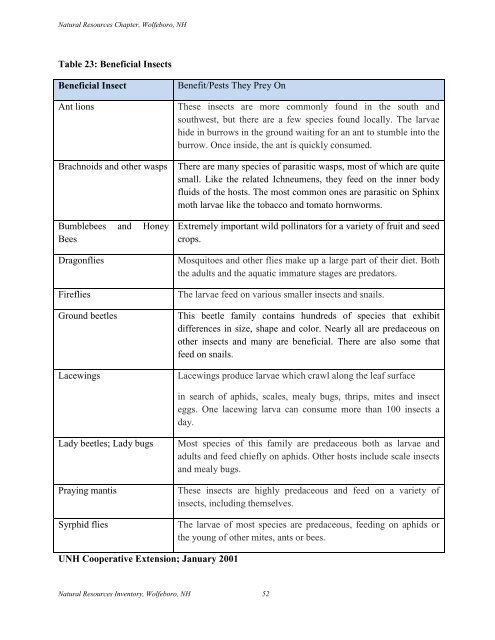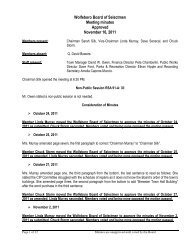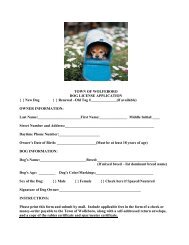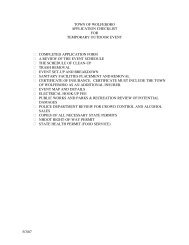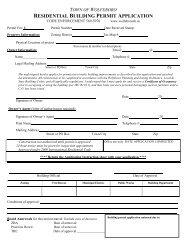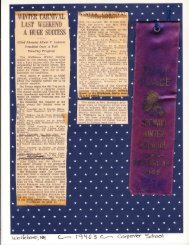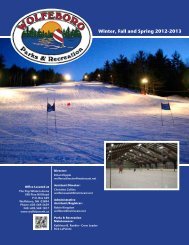Natural Resources Chapter of the Master Plan - Town of Wolfeboro
Natural Resources Chapter of the Master Plan - Town of Wolfeboro
Natural Resources Chapter of the Master Plan - Town of Wolfeboro
You also want an ePaper? Increase the reach of your titles
YUMPU automatically turns print PDFs into web optimized ePapers that Google loves.
<strong>Natural</strong> <strong>Resources</strong> <strong>Chapter</strong>, <strong>Wolfeboro</strong>, NH<br />
Table 23: Beneficial Insects<br />
Beneficial Insect<br />
Ant lions<br />
Brachnoids and o<strong>the</strong>r wasps<br />
Bumblebees and Honey<br />
Bees<br />
Dragonflies<br />
Fireflies<br />
Ground beetles<br />
Lacewings<br />
Benefit/Pests They Prey On<br />
These insects are more commonly found in <strong>the</strong> south and<br />
southwest, but <strong>the</strong>re are a few species found locally. The larvae<br />
hide in burrows in <strong>the</strong> ground waiting for an ant to stumble into <strong>the</strong><br />
burrow. Once inside, <strong>the</strong> ant is quickly consumed.<br />
There are many species <strong>of</strong> parasitic wasps, most <strong>of</strong> which are quite<br />
small. Like <strong>the</strong> related Ichneumens, <strong>the</strong>y feed on <strong>the</strong> inner body<br />
fluids <strong>of</strong> <strong>the</strong> hosts. The most common ones are parasitic on Sphinx<br />
moth larvae like <strong>the</strong> tobacco and tomato hornworms.<br />
Extremely important wild pollinators for a variety <strong>of</strong> fruit and seed<br />
crops.<br />
Mosquitoes and o<strong>the</strong>r flies make up a large part <strong>of</strong> <strong>the</strong>ir diet. Both<br />
<strong>the</strong> adults and <strong>the</strong> aquatic immature stages are predators.<br />
The larvae feed on various smaller insects and snails.<br />
This beetle family contains hundreds <strong>of</strong> species that exhibit<br />
differences in size, shape and color. Nearly all are predaceous on<br />
o<strong>the</strong>r insects and many are beneficial. There are also some that<br />
feed on snails.<br />
Lacewings produce larvae which crawl along <strong>the</strong> leaf surface<br />
in search <strong>of</strong> aphids, scales, mealy bugs, thrips, mites and insect<br />
eggs. One lacewing larva can consume more than 100 insects a<br />
day.<br />
Lady beetles; Lady bugs<br />
Praying mantis<br />
Syrphid flies<br />
Most species <strong>of</strong> this family are predaceous both as larvae and<br />
adults and feed chiefly on aphids. O<strong>the</strong>r hosts include scale insects<br />
and mealy bugs.<br />
These insects are highly predaceous and feed on a variety <strong>of</strong><br />
insects, including <strong>the</strong>mselves.<br />
The larvae <strong>of</strong> most species are predaceous, feeding on aphids or<br />
<strong>the</strong> young <strong>of</strong> o<strong>the</strong>r mites, ants or bees.<br />
UNH Cooperative Extension; January 2001<br />
<strong>Natural</strong> <strong>Resources</strong> Inventory, <strong>Wolfeboro</strong>, NH 52


